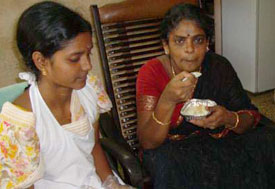Changing the color of the rice bowl to beat diabetes
September / October 2011 | Volume 10, Issue 5

Photo courtesy of Dr. V. Mohan
A Fogarty-supported research project studied the
most effective way of introducing healthy brown
rice into a culture used to consuming white rice.
Researchers are studying various ways of
combating India’s diabetes epidemic, including
healthier food choices.
A cultural hurdle had to be overcome before a study could demonstrate how a change in a dietary staple could reduce the incidence of diabetes.
Dr. Frank B. Hu of the Harvard School of Public Health wanted to test the efficacy of substituting brown rice, a whole grain, for white rice on biomarkers of diabetes risk in India, which has the largest number of diabetics in the world. There is evidence that consumption of whole grains can decrease diabetes by improving glycemic control.
With the assistance of co-investigator Dr. V. Mohan of the Madras Diabetes Research Foundation and a Fogarty International Research Collaboration Award, Hu discovered during a focus group session that participants believed brown rice to be inferior to their customary white rice. After explaining the nutritional and health values of brown rice during a tasting, "attitudes changed substantially among participants," Hu reported.
Some 200 participants have been randomized into two groups who will consume brown or white rice for breakfast and lunch for four months. Biomarkers related to glucose control will be measured. The goal is to provide data for use in designing a global dietary intervention study aimed at reducing diabetes risk through simple, feasible and sustainable dietary changes.
"I think brown rice can be a very inexpensive and very effective way of improving dietary risk factors at the population level," Hu said.
More Information
To view Adobe PDF files,
download current, free accessible plug-ins from Adobe's website.